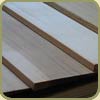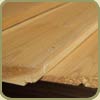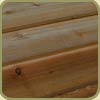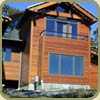
Bevel Siding
Bevel siding is a type of siding that is tapered or beveled so that its upper edge is thinner than its lower and lapped in laying to cover the horizontal joint between adjoining pieces. This type of siding allows the panels to protect the joints from water intrusion and extra wear. One of the reasons it’s so popular is that it’s easy to install, is long lasting, and looks beautiful. When it has a square butt end, it is traditionally known as Clapboard Siding. Bevel Siding with a notched butt end is known as “Dolly Varden” or Rabbeted Bevel.
When it comes to this type of siding, natural wood is the preferred choice for many homeowners due to its durability and natural beauty. The most commonly used woods include cedar, redwood, and pine.
Cedar is a popular choice due to its natural resistance to rot, decay, and insects. It is also naturally resistant to moisture, making it an ideal choice for homes in areas with high rainfall. Cedar is known for its warm, reddish-brown color and unique grain patterns, making it a popular choice for homes with a traditional or rustic aesthetic.
Redwood is another popular choice due to its natural resistance to rot, decay, and insects. It is known for its warm, reddish-brown color and unique grain patterns, making it a great choice for homes with a traditional or rustic aesthetic.
Pine is a less expensive option, but it is still a durable choice that can be finished to match your home’s color scheme. Pine is known for its light, natural color and its distinctive knots and grain patterns.

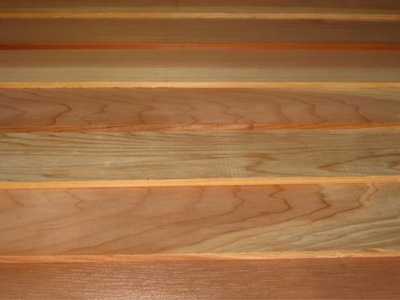

People love Western Red Cedar bevel siding because it provides a distinctive, stylish, and durable exterior for their homes. With its aesthetic appeal, energy-efficiency, easy installation, and versatility, bevel siding is a great choice for homeowners looking for a beautiful and long-lasting exterior for their homes.
Western Red Cedar bevel siding is the most common cedar siding type that is used and is created by sawing lumber at an angle to produce two pieces of wood that are thicker on one side and thinner on the other. This type of siding can be used on a variety of home styles, from traditional to contemporary, making it a versatile choice that can fit any design aesthetic. Additionally, it can be painted or stained to match your home’s color scheme, making it a customizable option that can fit your personal style.
Through the manufacturing process, bevel is produced to generally have one side that has a smooth surface and one side that has a resawn surface. We provide bevel siding in both knotty and clear grades. Clear siding is going to be used more in modern/contemporary homes, while knotty bevel is going to be used in more rustic settings.
One of the more economical options for Western Red Cedar bevel is to purchase what is called Finger-Joined bevel. This process includes gluing and joining shorter pieces of lumber to create longer pieces. The joins are stronger than the surrounding fiber. Typically this product is going to be pre-primed or painted prior to installation.
Bevels - Raw Lumber
All siding options are available in a variety of grades ranging from vertical grain clear to utility. BCL can offer any size of siding you may need. Click here for a Guide to Installing Bevel Siding.
Bevel siding is a popular choice for homeowners looking for a durable, attractive, and natural exterior for their homes. This type of siding offers numerous benefits that make it a great choice for your home.
Bevel siding is a type of natural wood siding that is characterized by its angled or beveled edge. Here are some of the benefits:
Natural beauty: It provides a warm and inviting appearance that adds character and charm to your home. The natural variations in color and texture give each piece of siding a unique look, making your home stand out from the rest.
Durability: Bevel siding is typically made from high-quality woods, such as cedar or redwood, which are naturally resistant to rot, decay, and insects. This makes bevel siding a durable option that can withstand the elements and maintain its beauty for many years.
Weather resistance: It is designed to shed water, helping to prevent water damage and rot. This makes it an ideal choice for homes in areas with high rainfall or harsh weather conditions.
Easy to install: Bevel siding is relatively easy to install, making it a cost-effective option for your home. With the right tools and some basic carpentry skills, you can install your own bevel siding, saving you time and money on installation costs.
Adds value to your home: It adds value to your home by enhancing its overall appearance and increasing your home’s curb appeal. Whether you’re looking to sell your home in the future or simply want to enjoy its beauty for many years to come, bevel siding is a great investment.
In conclusion, bevel siding is a great choice for homeowners looking for a durable, weather-resistant, and attractive siding option. With its natural beauty, durability, and ability to add value to your home, bevel siding is a smart investment that will provide years of enjoyment for you and your family. Whether you’re building a new home or updating an existing one, consider the many benefits of bevel siding and make it your choice for a beautiful and functional exterior.
Bevel Siding Coverage Estimating Table
| Nominal Width | Net Width | Pattern Face | Sq Ft To Lineal Feet | Sq Ft To Board Feet |
|---|---|---|---|---|
| 4 | 3 - 1/2 | 2 - 1/2 | 4.8 | 1.6 |
| 6 | 5-1/2 | 4-1/2 | 2.67 | 1.33 |
| 8 | 7-1/4 | 6-1/4 | 1.92 | 1.28 |
| 10 | 9-1/4 | 8-1/4 | 1.45 | 1.21 |
| 12 | 11-1/4 | 10-1/4 | 1.17 | 1.17 |




